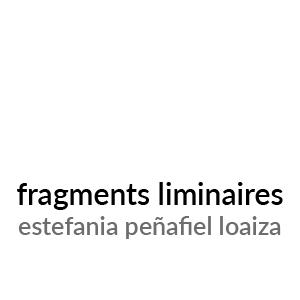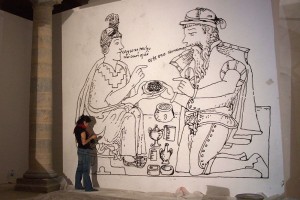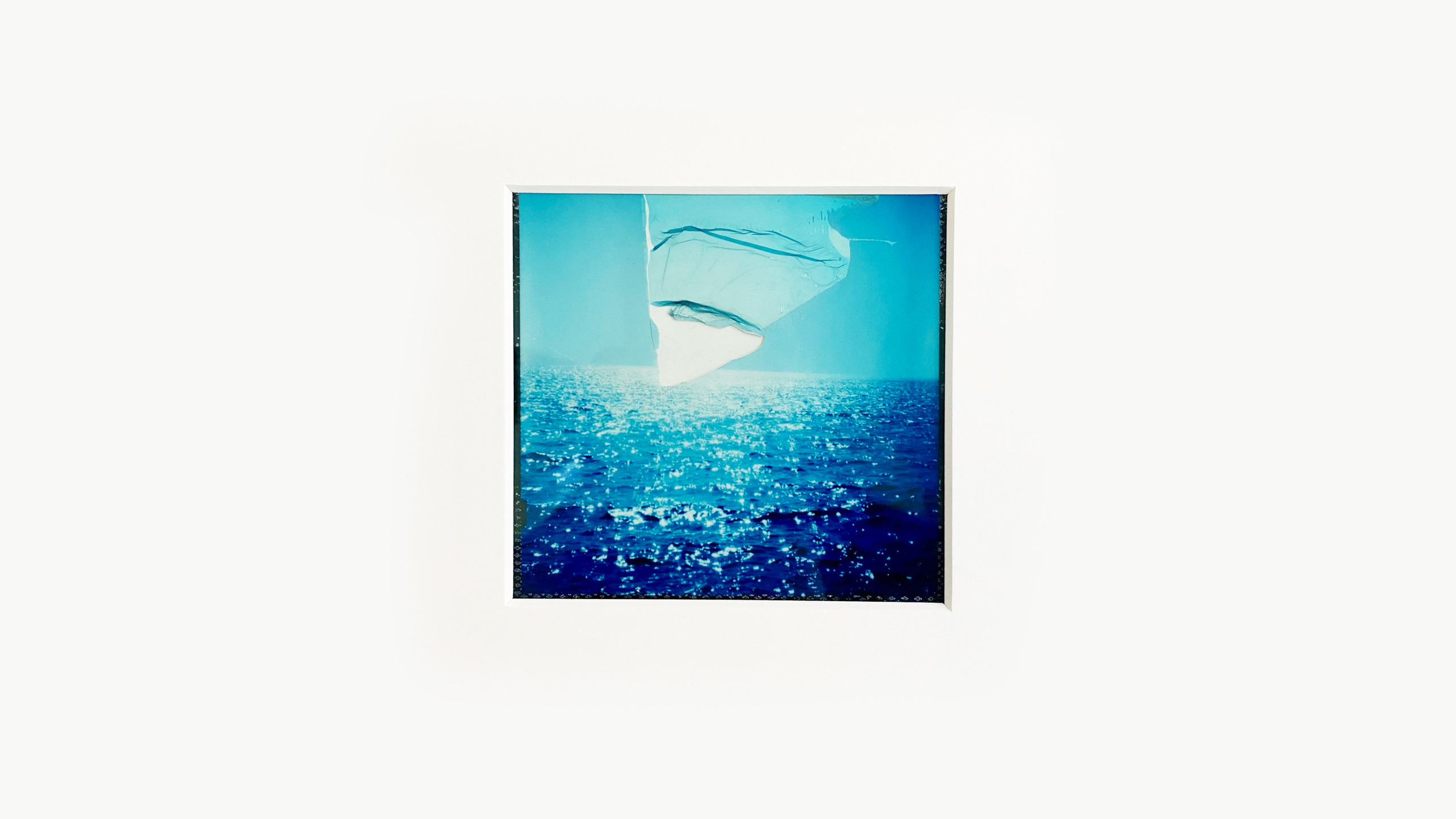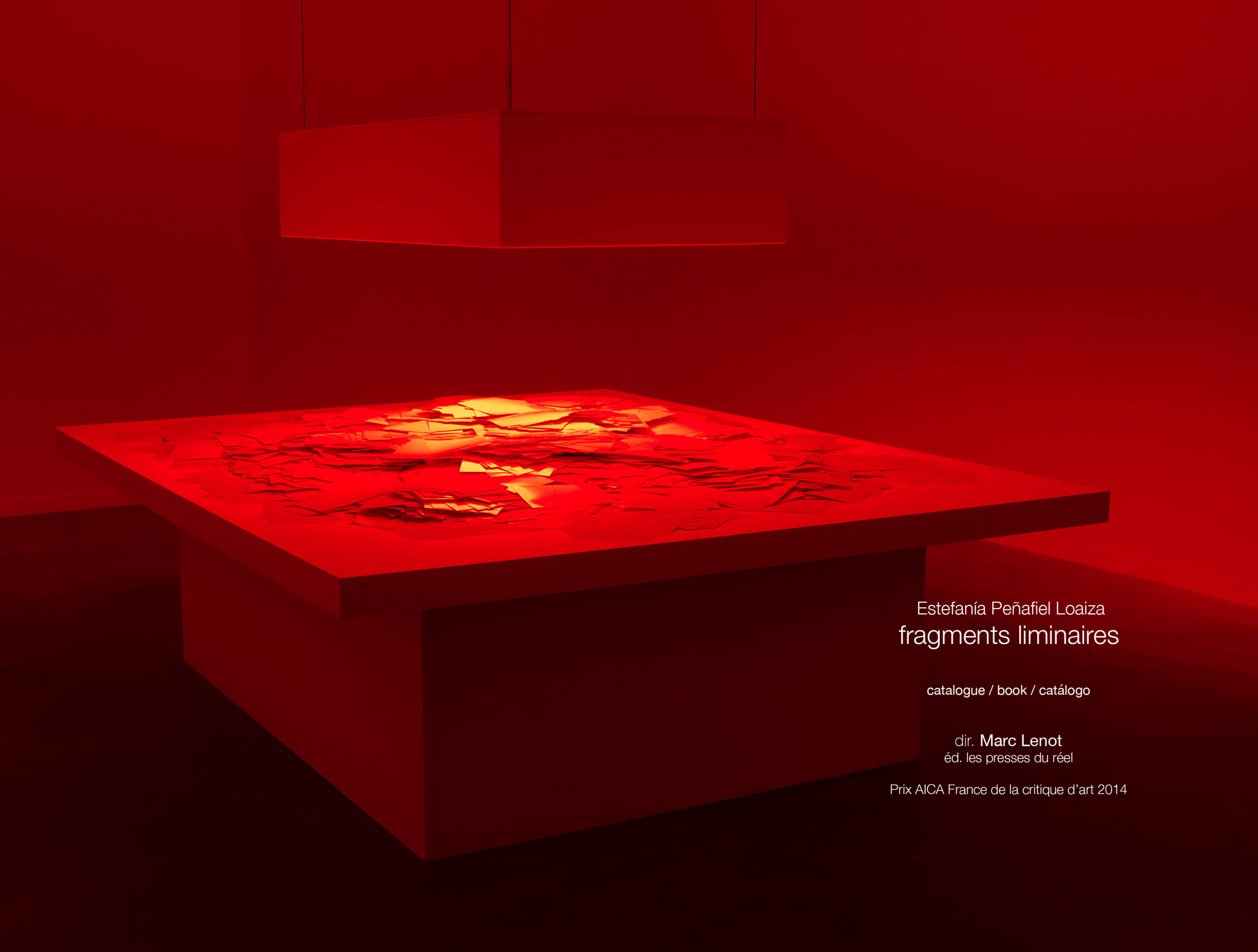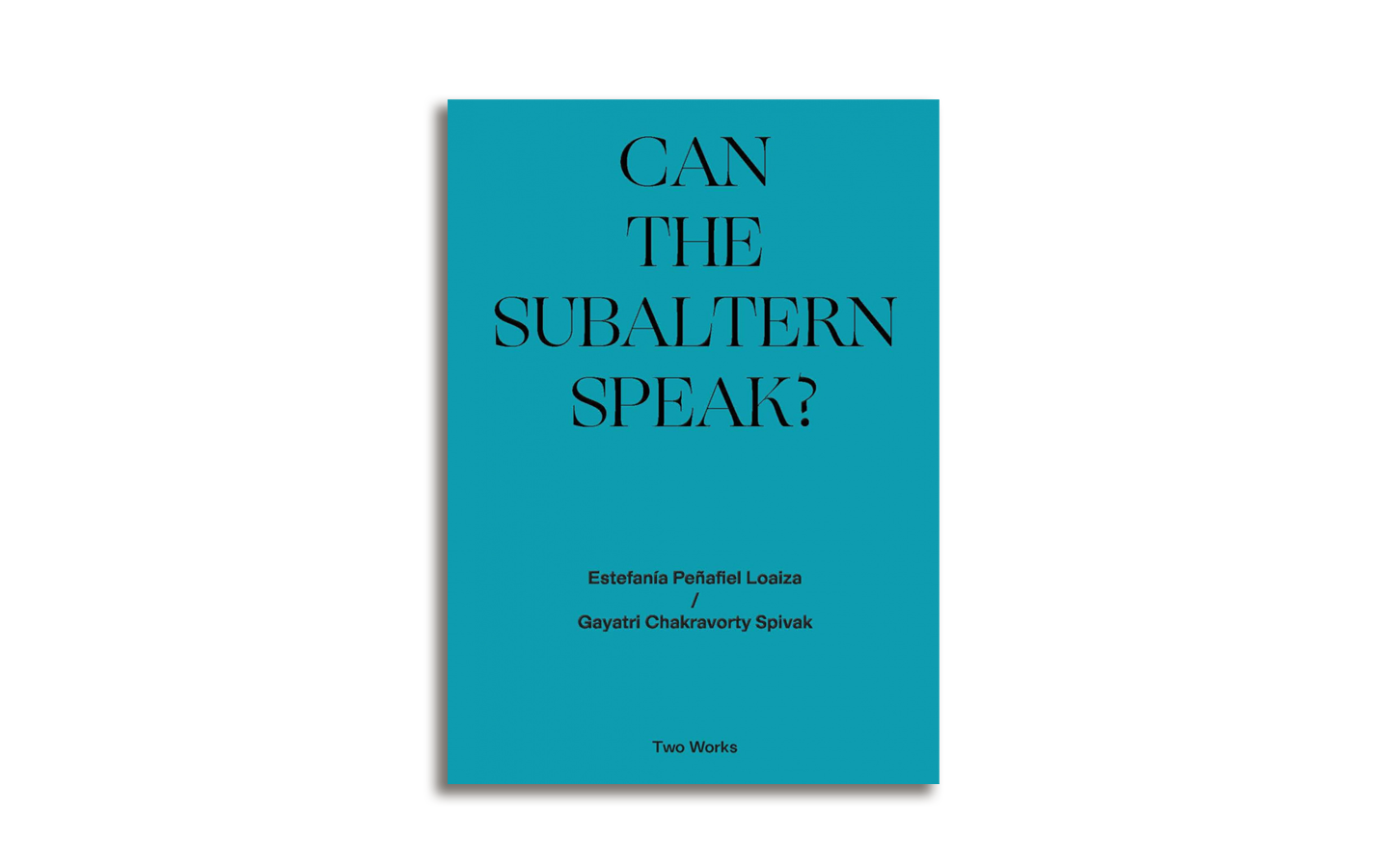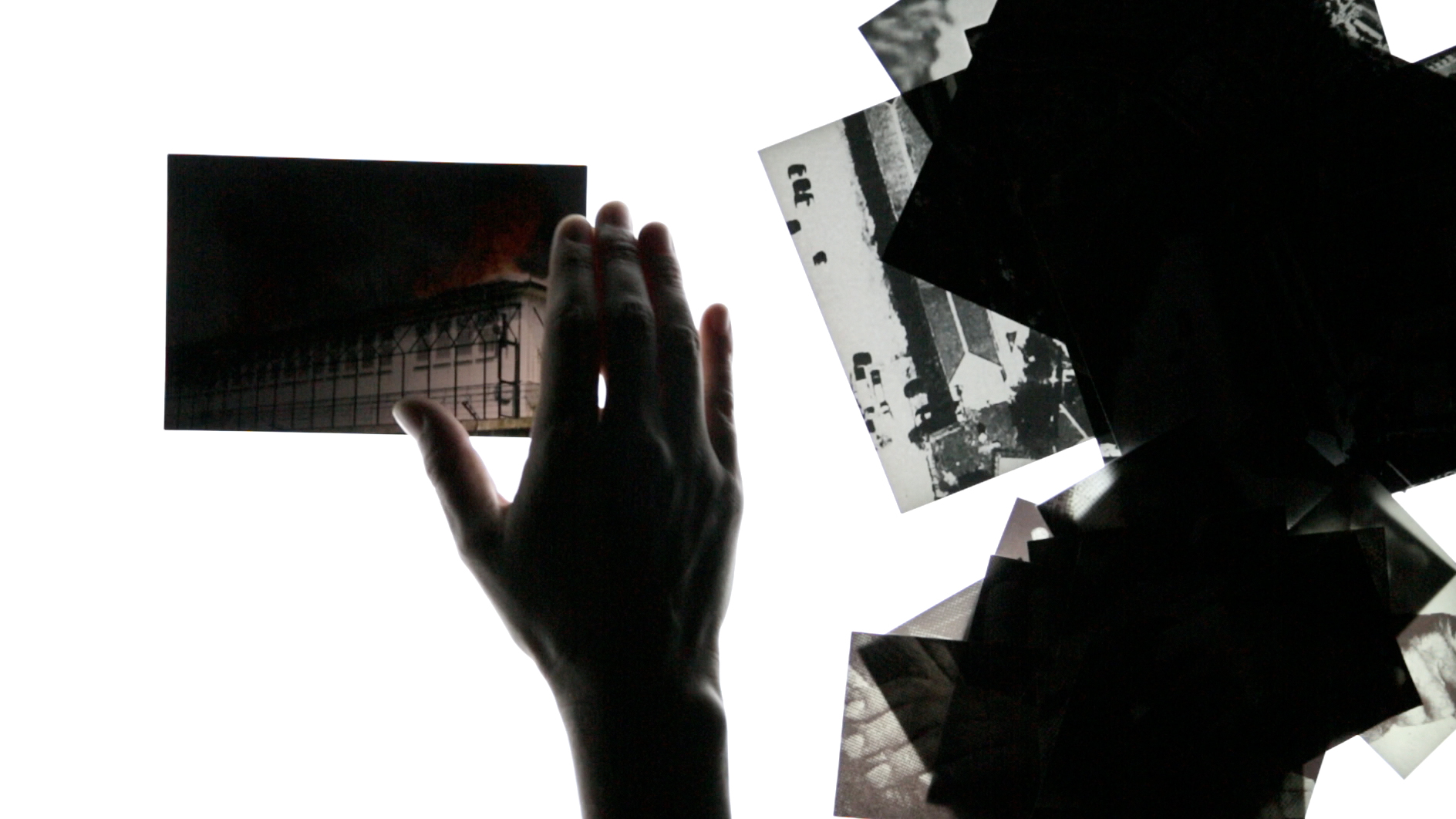An outward gaze, a different gaze, a persistent gaze…
Lupe Álvarez
Article published at fragments liminaires : Estefanía Peñafiel Loaiza (Les Presses du réel, 2015), reproduced with the authorization of the autor. The book can be adquiere here.
“An outward gaze, a different gaze, a persistent gaze…”1 Before she was thirty, Estefanía Peñafiel Loaiza had thoroughly explored the essence of her approach: to sound out the deep vacuums, the areas off camera, the puckers of a complex world where oblivion and omission provide perfect antidotes to the anxiety created by coming to grips with it. There is a substantial correlation between the emphasis on peripheral vision and this young artist’s work, but the hallmark of this vast process that seeks to endow the gaze with a different economy is her ability to rally and mobilize the viewer. Her tools abound in subtle artifices and keys that are designed to cause discomfort and, in so doing, to exorcise the unspoken elements which, in our western way of giving meaning to the world, stem, historically, from an ambitious notion: that of a true subject, armed with instruments that provide reliable reference points.
Peñafiel has tested her strength against two procedures which account for much of present-day artistic output: the weakening of symbols and the use of the spectacular as a bait to draw attention. Her work, on the contrary, seems pervaded by something of the power of silent movies, in which the absence of words combines with the metaphorical qualities implicit in certain situations and contexts, a power which she activates and moderates efficiently. These qualities are enhanced by the use of basic tools and technological resources which, though unsophisticated, are intensified to an extraordinary degree, and by an accurate understanding of space as an environment of multiplicities. This allows her, as she has remarked, to “let images speak”. And her strong point is precisely that she enlists the potential of images to make us think and, as José Luis Brea pointed out, to cause knowledge of the unperceived to appear in them.2 In fact, thanks to her allusive capability, she makes it clear that the very thickness of the images and the role they play in the formation of worlds have turned them into ways of thinking that are dependent on the ability to use an “optical mind” to relate and perceive links that transcend eras and contexts while at the same time questioning the scattered, hazy present.
The artist uses a blend of symbolic devices to create these situations. She moves about with ease in an extended universe of media – everything from technically reproducible languages and plastic art traditions to different types of performance art such as installations and situational aesthetics – while continually calling upon them to enhance the political potential of art. Image banks and archives have been a particularly vital source of input to her poetics. Their legacies, examined as debris or footprints, help her build up a battery of challenges aimed at a historical order conceived in the light of the equivalence between Universal Reason, Representation and Truth.
Peñafiel has honed her rhetoric by arming herself with wisdom in her quest to find images, understand them and put them to work by pointing out what is lacking in them. Some of her works belong to the field of postcolonial aesthetics, in that they alert us to the neuralgic points of modernity’s civilization project. In a certain idea of paradise 1. este oro comemos (after Guamán Poma de Ayala) [fig. 1], she takes a drawing from the famous document El primer nueva corónica y buen gobierno (The First New Chronicle and Good Government), in which an indigenous chronicler denounces the abuses of Spanish colonization. The artist’s gesture – she reproduces the drawing in Swiss chocolate made from Ecuadorian cocoa directly on the wall of an exhibition room in Geneva – could hardly be more forceful. The picture of an Inca and a Conquistador exchanging products amounts to an update, in allegorical form, of the international division of labour that still constitutes modernity today: the historical sentence that condemns our countries of the South to be producers of raw materials and exporters of manual labour, thus defining their predetermined role in global chains of values. Peñafiel draws with meticulous dedication, emulating the graphic quality of the manuscript and evoking, through the material’s strong appeal to the senses, our historical association with a nature subordinated by hegemonic cultural constructions.
Other gestures involving the body in different ways also cut across her poetics. Sometimes the references come from the travel journal Ecuador, written in 1928 by the French poet and painter Henri Michaux. Peñafiel’s own sense of belonging and identity – she settled in Paris many years ago – is stirred up by these works. Many consider Michaux’s logbook an “exoticizing” narrative. It fits her like a glove, however, for on her visits to her home country, she is faced with ways of understanding identity – as the traditional, problem-free relationship between habit and habitat – that are so dear to substantialist thought.
In the video-installation preface to a cartography of an imagined country Peñafiel joins the laborious exercise of writing backwards to the semantic potential of the act of filming in order to embody all those aspects of experience that are related to the body, aspects which writing can only outline and express by skirting round an experience that spills over from them.When she re-reads the French writer’s text from her new place as an emigrant, her own ideas and images of the land of her birth re-emerge, blurred and disarranged… Michaux’s tales are relocated in her own world view, yet at the same time she finds herself in them, so that the possibility of reading them only from here, or from there, ultimately vanishes.
In another of her works, the video cartographies 1. the crisis of dimension [fig. 2], she returns to the same topic. An open book lies on a table. The right-hand page is blank. A hand comes on camera, the fingers run across the surface and, as they rub the page, the missing text appears. How many questions this simple, silent shot raises! Countless thoughts about new senses of belonging, identity and affection seem to converge here. Introverted notions of place totter and identity is proposed as something that constitutes an indiscernible, delocalized amalgam of world meanings, in which the link to other places moderates the perspective of recognition and belief. The gesture updates the upheaval that ensues when accumulated certitudes about one’s native land, which are not usually questioned, are shaken. These are works in which a well-chosen gesture is allowed to speak, a gesture full of meanings which, because it is corporal, as Didi-Huberman says, bears within it the feelings and sensations it allows to surface.3
Her readings (in reverse) of the eighteen constitutions of the Republic of Ecuador are another manifestation of this type of apt gesture which implies a painful reversal of bodily logic, a re writing based on the experience of learning to un-do and un-say. This work in progress4, which she began in 2005, is entitled countdown and combines performance art and video. Here the gesture appears to revive Michel Foucault’s appeal for certainty when he questioned the truth of words and warned us, in dagger-sharp terms, of their falsehood: “For a long time it was believed that language was the master of time, that it was equally valid as a link to the future, through the word given, and as a memory and narrative; it was believed that it was both prophecy and history […], that it had the power to cause the visible and eternal body of truth to appear […]. But it is nothing but a shapeless, trickling sound”.5
Eighteen constitutions for an always faulty democratic State trapped in its own rhetoric: here the act of truth is not to be found in the words, but in the fact that the use made of words in art can un-conceal and bring to awareness.
Peñafiel’s approach emphasizes the exploration of infrathin social phenomena which are captured by poetical gestures designed to activate meaning through some subtle action. In on exactitude in science, an early 20th century atlas is slit along a line purporting to be the Equator, as whimsically conceived in the time of the Surrealists. The work is a veritable statement about the political fictions that lie behind the empirical sciences, their claims and their certitude-generating tools. Here again we find the crisis of modern narratives of the Enlightenment and progress, along with an elegant warning that the image of the world they produced is decaying.
The city, the space par excellence where modern life unfolds, is another recurring theme in Peñafiel’s work. It has enabled her to lure into the image those things which emerge, not from what is objectively seen, but from what is lacking, what is absent, or hidden by dazzle. It is here that the web of social relationships that extend through urban imaginations and images is uncovered, along with the connotations of the division of urban space and of the assignment of places.
To accomplish this task, the artist has had to draw on the representational powers of images – some taken especially by her, others borrowed from the media. The fundamental trait of these sources is their scant constancy, as fragments of memory, or scraps. In the installation cherchant une lumière garde une fume, thousands of images of fires that have broken out in various cities are obscured by the red light of a lamp. The room is in darkness and the only thing “visible” is this accumulation in the centre. The images are presented as something that exists, but, however absorbed we become in capturing them as the signs of some sort of truth, their very existence melts away. For the closer the images come to the light, the more they are dazzled into disappearance. This work reminded me of a thought expressed by Irmgard Emmelhainz: “Although it is related to the optic nerve, the picture does not make an image. In order to make images, it is necessary to make vision assassinate perception; it is necessary to ground vision, and then perform (as in artistic activity) and think vision (as in critical activity).”6
This same approach, which consists of exploring the critical dimension of images, underlies the invisible cities 3. the spark (Vincennes 2008), an installation in which slides are projected onto a phosphorescent screen standing on the floor. They show aerial shots of the administrative detention centre for irregular immigrants in Vincennes. At a detailed level, the finite demarcations of the layout are visible but the continuous, relentless succession of superimposed images causes them to flash past. This impersonal view provides a fleeting glimpse of the geometry of the place, which is both present and diffused. It is a disturbing work in which all the imaginary “benefits” of globalization intersect and clash. If this condition is related, in the discourse, to international integration, free trade and the free circulation of labour, what guarantee is there that these “detained” persons will be free to choose their own living conditions? The broader reflection raised by a work like this undermines Foucault’s notion that “discipline proceeds from the distribution of individuals in space”.7 Similarly, as Braudel points out, limits are the first thing to appear in spaces where otherness is seen as a menace and people find themselves separated for upsetting the sense of security which has been built up in a given territory over history.8
a room with a view (mode d’emploi) is another video installation that touches on ways of life inherent to the situation of migrants: their subjectivity, which hinges on displacement, uprooting and the reconstruction of the feeling of privacy or home, and even the problematic singularity of their situation, determined by statistics, legal documents, and integration protocols. This work was conceived while the artist was in residence in Beirut. It comprises documents, files and photographs evoking associations adrift in the encounter between diverse realities and the introjection of interwoven experiences in which, yet again, shifting references and impersonal images cancel out any fixed sense of identity.
Along the same lines, the photographic series an air of welcome is a striking commentary on problems to do with mobility, frontiers, and the geometry of power. By leaving her camera shutter open for a considerable lapse of time, the artist captures images of groups of immigrants crossing the borders between Mexico and the United States, and Palestine and Israel, as recorded by the frontier surveillance cameras. In so doing she accepts the evidence of the recording device but converts it into a blurred image of the furtive migrants. Once again a particular type of productivity associated with a technological medium provides a view rife with ideological connotations. A surveillance camera set up on frontiers like these – among the most explosive in the world – is capable of shifting the viewpoint to the extent that it becomes itself an out-of-focus subject which, like a technologically enhanced prosthesis, accentuates aspects that are excluded from normal vision. By accepting the significance of the medium as a detonating device, the work stresses the idea that “with the enabling of the visualization of data by machines, images have become scientific, managerial, and military instruments of knowledge, and thus of capital and power.”9The artist, however, dramatizes the revenge poetically through the indelible gesture of erasure, as though averting danger by restoring to the uncrossable limit a liminal possibility.
Lupe Álvarez, Miraflores, April 15, 2015
Lupe Álvarez is an academic, art critic, and curator based in Ecuador. Her theoretical work at the Instituto Superior de Arte in Havana accompanied the New Cuban Art movement. Álvarez founded the Chair of Theory of Artistic Culture at the University of Havana. In 1998, she moved to Ecuador, where she became a researcher at the Centro Ecuatoriano de Arte Contemporáneo. As a curator at MAAC, Guayaquil, Álvarez co-curated Umbrales del Arte en el Ecuador, and curated the collection of modern and contemporary art at the Museo Municipal of Guayaquil. Álvarez was a founder of the Instituto Tecnológico de Artes del Ecuador (ITAE), where she is currently a teacher and the head of the Research Department.
NOTES :
-
The title of the text is taken from a phrase in the artist’s own statement.
-
José Luis Brea, Cambio de régimen escópico : del inconsciente óptico a la “e-image”, Revista de Estudios Visuales, n° 4, 2007. Retrieved fron http://www.estudiosvisuales.net/revista/pdf/num4/JlBrea-4-completo.pdf (consulté le 23/04/2015).
-
Interview with George Didi-Huberman by Pedro Romero, “Un conocimiento por el montaje”,
Revista Minerva 2007, retrieved from 23 April 2015. http://www.revistaminerva.com/articulo.php?id=141 -
In English in the original (Translator’s note)..
-
Michel Foucault, El pensamiento del afuera, Pre- Textos, Valencia, 1989, Spanish translation by Manuel Arranz [La pensée du dehors, in Dits et écrits, Volume 1, 1954-1975, text No. 38, “Sur Maurice Blanchot”, art. published in Critique No. 229, pp. 523-546, June 1966].
-
Irmgard Emmelhainz, “Condiciones de visualidad bajo el Antropoceno y las imágenes que están por venir”, SalonKritik, 05/04/2015, retrieved from http://salonkritik.net/10-11/2015/04 post_28.php, 23 April 2015. This quotation from Emmelhainz itself contains two references: Serge Daney, “Avant et après l’image” (interview), Revue d’Études palestiniennes, summer 1991; and Georges Didi-Huberman, ‘“Tableau=coupure”: Expérience visuelle, forme et symptôme selon Carl Einstein”, Cahiers du Musée national d’art moderne 58, winter 1996, pp. 5-27.
-
Quoted by David Morley, “Pertenencias. Lugar, espacio e identidad en un mundo mediatizado”, in Leonor Artuch (compiler), Pensar este tiempo. Espacios, afectos, pertenencias, Paidós, Buenos Aires, 2005. [“Belongings. Place, space and identity in a mediated world.” European Journal of Cultural Studies, November 2001.]
-
Fernand Braudel, Ibid.
-
Benjamin Bratton, “Some Trace Effects of the Post-Anthropocene: On Accelerationist Geopolitical Aesthetics,” e-flux journal 46 (June 2013): par. 16. Quoted by Irmgard Emmelhainz, op. cit.
__________________________________________________________________________________________________
